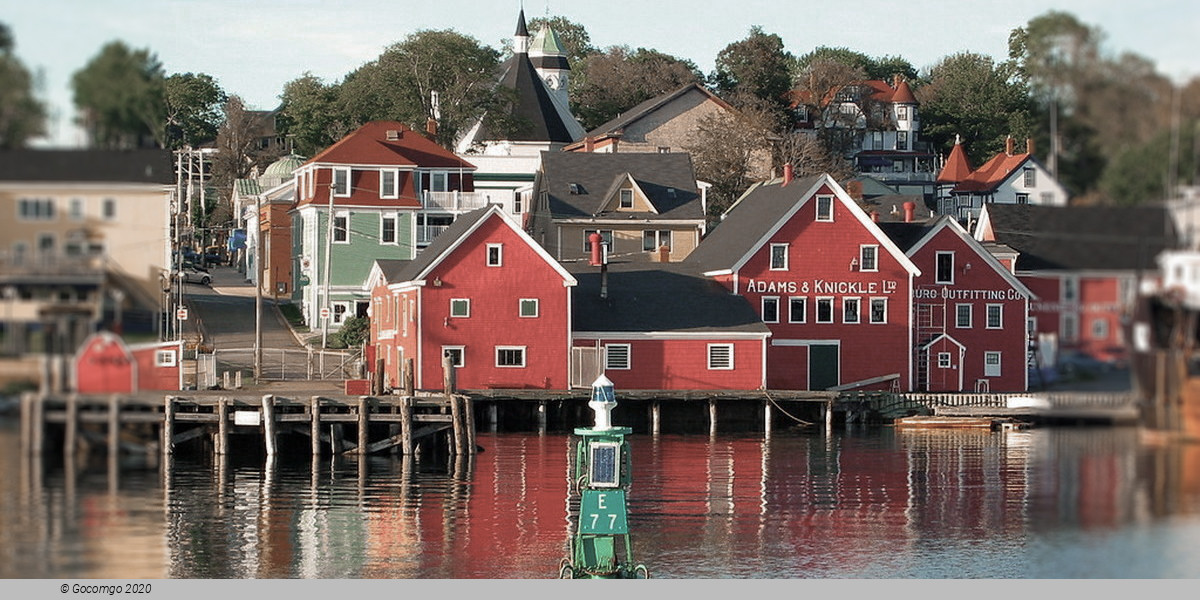Lunenburg

Lunenburg is a port town on the South Shore of Nova Scotia, Canada. Founded in 1753, the town was one of the first British attempts to settle Protestants in Nova Scotia. The economy was traditionally based on the offshore fishery and today Lunenburg is the site of Canada's largest secondary fish-processing plant. The town flourished in the late 1800s, and much of the historic architecture dates from that period. In 1995 UNESCO designated it a World Heritage Site. UNESCO considers the site the best example of planned British colonial settlement in North America, as it retains its original layout and appearance of the 1800s, including local wooden vernacular architecture.
History
The Mi'kmaq lived in a territory from the present site of Lunenburg to Mahone Bay. As many as 300 inhabited the site in the warm summer months. French colonists, who became known as Acadians, settled in the area around the 1620s. The Acadians and Mi’kmaq co-existed peacefully and some intermarried, creating networks of trade and kinship. In 1688, 10 Acadians and 11 Mi’kmaq were residents with dwellings and a small area of cultivated land. By 1745 there were eight families.
When Edward Cornwallis, newly appointed Governor of Nova Scotia, visited in 1749, he reported several Mi’kmaq and Acadian families living together at Mirliguèche in comfortable houses and said they "appeared to be doing well."
Britain and France carried their military conflicts in Europe in the 1700s to the New World. Under the 1713 Treaty of Utrecht, France ceded the part of Acadia today known as peninsular Nova Scotia to Britain. To guard against Mi'kmaq, Acadian, and French colonial attacks, the British erected Fort George in 1749 at Citadel Hill Halifax and founded the town of Halifax.
The British sought to settle the lands with loyal subjects and recruited more than 1,400 Foreign Protestants, mostly artisans and farmers, from Europe in July 1753 to populate the site. The British had failed to provide promised land in Halifax to many of these settlers and they had become frustrated, causing problems for the British. The resettlement thus served the additional purpose of removing many of the Foreign Protestants from Halifax. Led by Charles Lawrence, the settlers were accompanied by about 160 soldiers. They assembled prefabricated blockhouses and constructed a palisade along the neck of land where the village was laid out. The settlers spent the summer building shelters for the winter and, not having been able to conduct any fishing or farming, had to be provisioned from Halifax. When the settlers became dissatisfied with the distribution of provisions and due to general distrust and frustration from mistreatment by the British, they rose in armed rebellion in The Lunenburg Rebellion and briefly declared a republic, only to be put down by troops led by Colonel Robert Monckton. Others defected to the Acadian side. In 1754 the town had a sawmill and a store.
In 1755, after the expulsion of the Acadians, the British needed to repopulate vacated lands. It offered generous land grants to colonists from New England, which was experiencing a severe shortage inland. Today these immigrants are referred to as the New England Planters. Lunenburg was raided in 1756 by a mixed group of Mi'kmaq and Maliseet raiders, devastating the town. The attacks continued on the British with the Lunenburg Campaign of 1758. Hostilities with Mi'kmaq ended around 1760.
During the American Revolution, privateers from the rebelling colonies raided Lunenburg, including the 1782 raid, devastating the town once again. The town was fortified at the beginning of the War of 1812. The British officials authorized the privateer Lunenburg, operated by Lunenburg residents, to raid American shipping.
Over the following years, port activities transitioned from coastal trade and local mixed fisheries to offshore fisheries. During the Prohibition in the United States between 1920 and 1933, Lunenburg was a base for rum-running to the US.
The Lunenburg Cure was the term for a style of dried and salted cod that the city exported to markets in the Caribbean. Today a large hammered copper cod weather vane is mounted on the spire of St. Andrew's Presbyterian Church.
The Smith & Rhuland shipyard built many boats, including Bluenose (1921), Flora Alberta (1941), Sherman Zwicker (1942), Bluenose II (1963), Bounty (1961), and the replica HMS Surprise (1970). In 1967 the yard was taken over by Scotia Trawler Equipment Limited. After the end of World War II, shipbuilders switched from producing schooners to trawlers, aided by migrant labor from Newfoundland.

